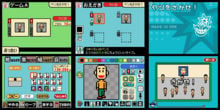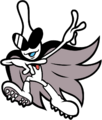WarioWare: D.I.Y.: Difference between revisions
mNo edit summary |
mNo edit summary |
||
| Line 13: | Line 13: | ||
| input = | | input = | ||
}} | }} | ||
'''''WarioWare: Myself''''', known as '''''Made in Ore''''' (メイド イン 俺 ''Meido in Ore'', | '''''WarioWare: Myself''''', known as '''''Made in Ore''''' (メイド イン 俺 ''Meido in Ore'', lit. "Made in Me") in Japan, is a title in the [[WarioWare (series)|''WarioWare'' series]]. It was confirmed on October 2 at the Fall 2008 Nintendo Conference, where are very short footage was shown. The game was released on April 29, 2009 in Japan for the [[Nintendo DS]] and allows the player to create his or her own [[microgame]]s, music and comics, hence the title. The content can be shared via the [[Nintendo Wi-Fi Connection]].<ref>[http://www.1up.com/do/newsStory?cId=3173648 1UP.com]: Make Your Own WarioWare Games (04/08/2009)</ref> | ||
== Features == | == Features == | ||
| Line 49: | Line 49: | ||
</gallery></center> | </gallery></center> | ||
== Artwork == | == Official Artwork == | ||
<center><gallery> | <center><gallery> | ||
Image:Wario Penny WWM.png|[[Wario]] and [[Penny Crygor|Penny]] | Image:Wario Penny WWM.png|[[Wario]] and [[Penny Crygor|Penny]] | ||
Revision as of 10:18, April 29, 2009
Template:Justreleased Template:Infobox WarioWare: Myself, known as Made in Ore (メイド イン 俺 Meido in Ore, lit. "Made in Me") in Japan, is a title in the WarioWare series. It was confirmed on October 2 at the Fall 2008 Nintendo Conference, where are very short footage was shown. The game was released on April 29, 2009 in Japan for the Nintendo DS and allows the player to create his or her own microgames, music and comics, hence the title. The content can be shared via the Nintendo Wi-Fi Connection.[1]
Features
The player is able to make own graphics, music and logic routines for his or her microgames. The tools for creating the artwork are partly taken from Mario Paint, and even the respective graphics resemble the visuals of the named game. Furthermore, Myself offers the possibility to create comics.
The game is divided into three sections:
- My House: The main section of the game where the player does all the work and creates the microgames.
- WarioWare, Inc.: The game's tutorial hosted by Penny Crygor.
- My Shop: In this section, the player saves the microgames and puts them together. "Famicom carts" can be designed for the microgames.
The tools for graphical editing include different pencil tools, spray can, fill tool and eraser. They are used for both background elements and sprites which can be easily placed and moved around. The game allows to program logic routines to define the game's rules.
Music can be made as well. The respective tool is similar to the Music Mode of Mario Paint. Instead of manually placing the notes on the music score, the player can also sing through the DS's microphone, which the DS then converts into the notes. Many of the instruments useable for the created melody originate from Mario Paint. The premade sound effects are partly taken from Mario Paint, too.
A separate utility allows to create black and white four-panel comics.
Players can make their creations available to other Myself owners. They can also be uploaded to Nintendo for contest purposes. Microgames made available by Nintendo can be downloaded, too. Additionally, a game called Asobu Made in Ore will be released on WiiWare and allows to play the self-made games and games made by other players on the Wii.
90 premade microgames are already available from the beginning. They are split into five different sets hosted by different WarioWare employees. Similar to the first game in the series, each set is based around a certain theme:
Screenshots
In the first footage, the player designed a microgame about popping a balloon. Basic steps of the making were shown.
Official Artwork
- Jimmy T. WWM.png
- Ashley WWM.png
- 9-Volt WWM.png
Trivia
- The word ore (俺) is a rough or arrogant-sounding first-person pronoun in Japanese. The use of the word in the Japanese title is in line with Wario's personality.







